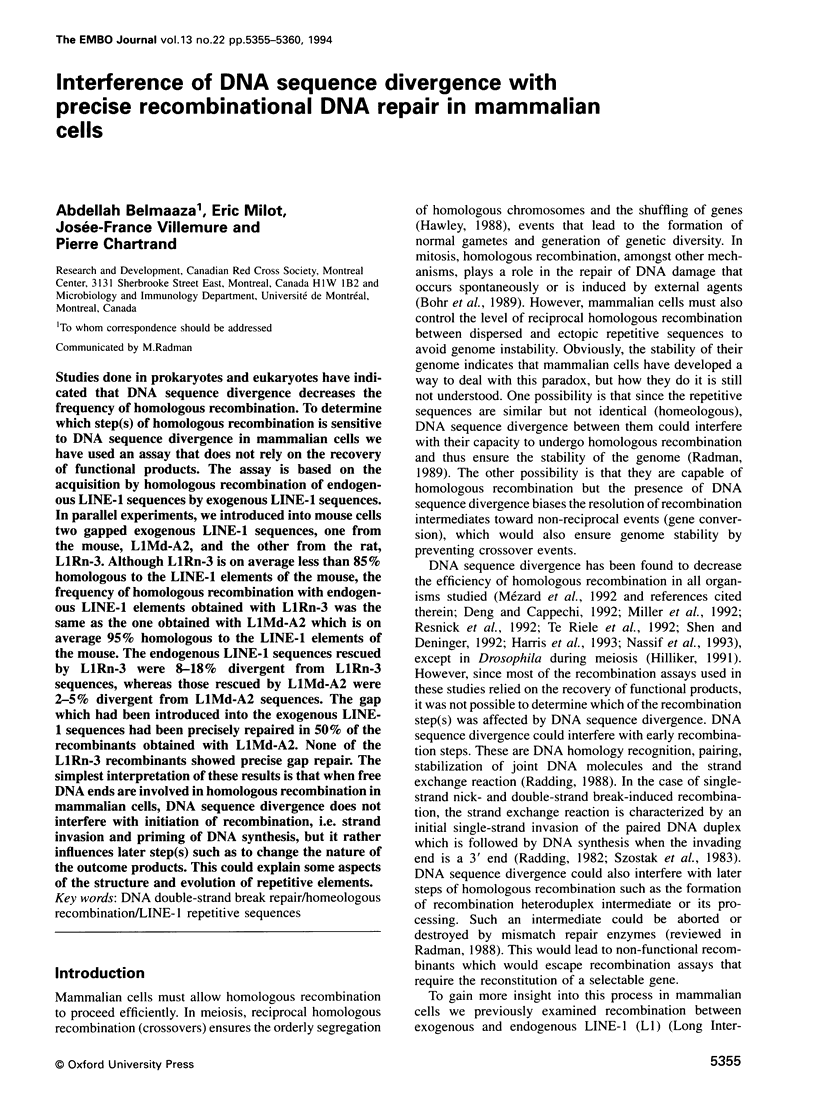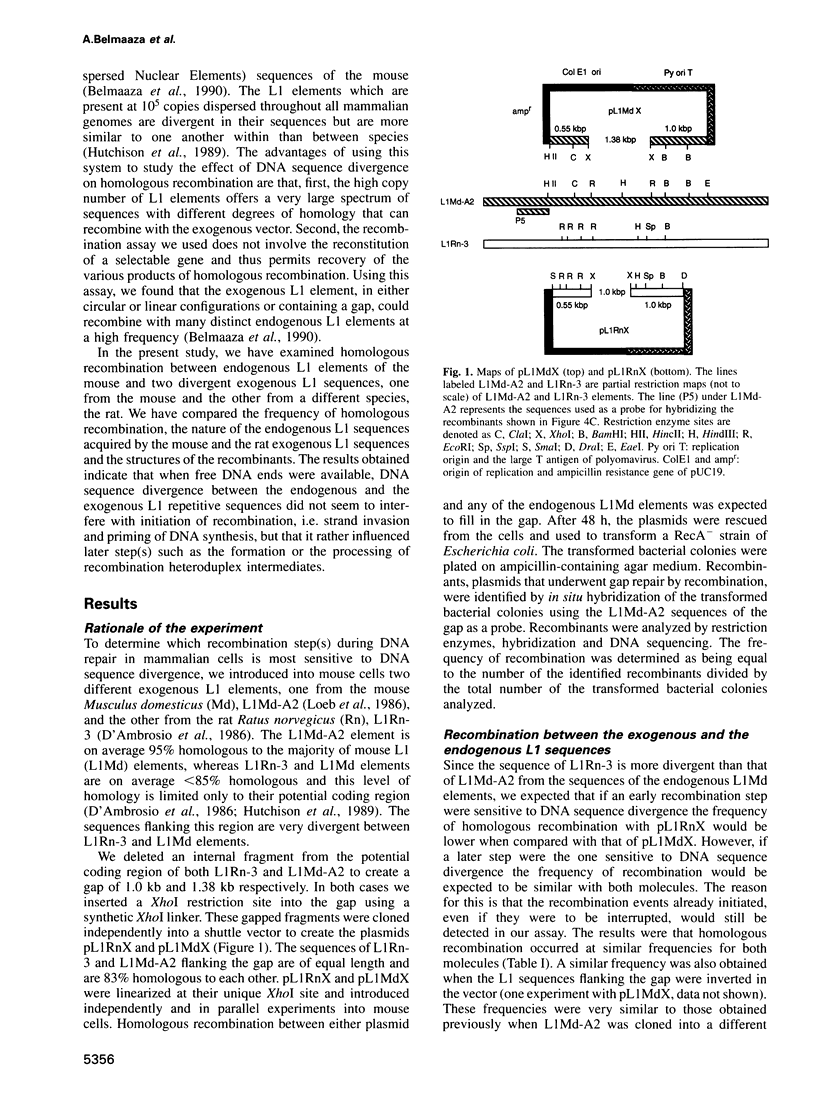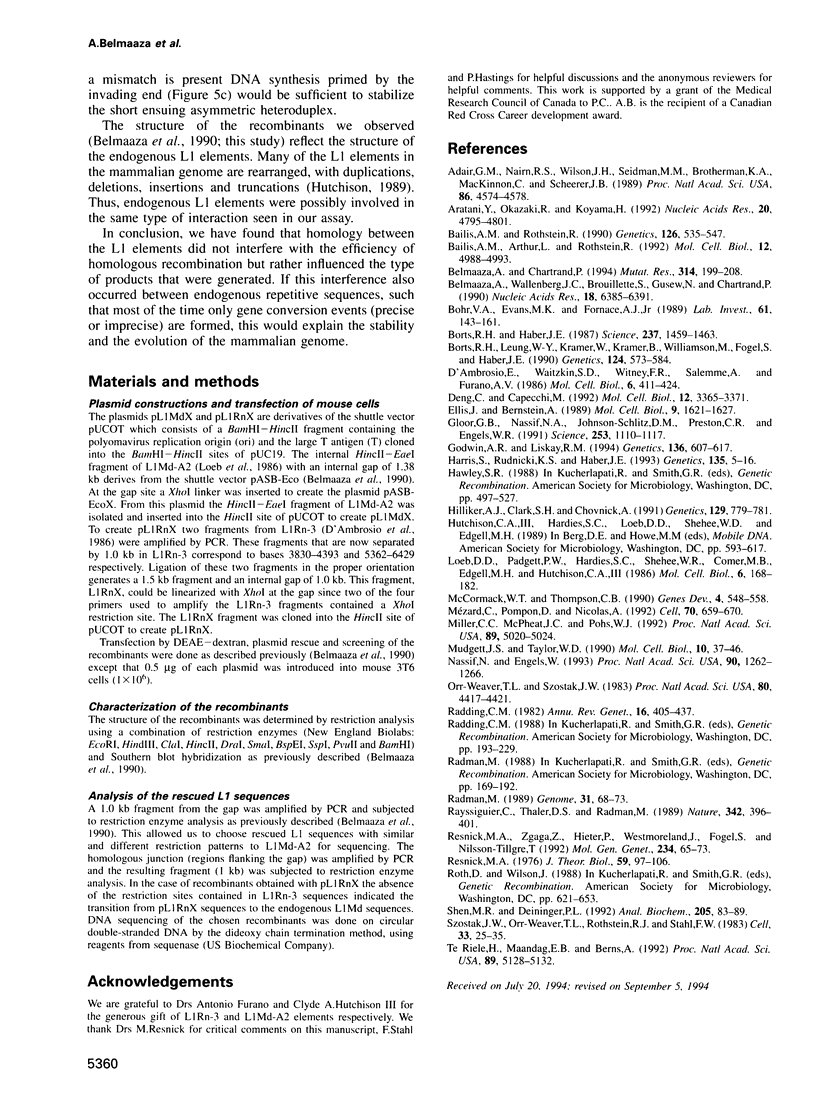Abstract
Studies done in prokaryotes and eukaryotes have indicated that DNA sequence divergence decreases the frequency of homologous recombination. To determine which step(s) of homologous recombination is sensitive to DNA sequence divergence in mammalian cells we have used an assay that does not rely on the recovery of functional products. The assay is based on the acquisition by homologous recombination of endogenous LINE-1 sequences by exogenous LINE-1 sequences. In parallel experiments, we introduced into mouse cells two gapped exogenous LINE-1 sequences, one from the mouse, L1Md-A2, and the other from the rat, L1Rn-3. Although L1Rn-3 is on average less than 85% homologous to the LINE-1 elements of the mouse, the frequency of homologous recombination with endogenous LINE-1 elements obtained with L1Rn-3 was the same as the one obtained with L1Md-A2 which is on average 95% homologous to the LINE-1 elements of the mouse. The endogenous LINE-1 sequences rescued by L1Rn-3 were 8-18% divergent from L1Rn-3 sequences, whereas those rescued by L1Md-A2 were 2-5% divergent from L1Md-A2 sequences. The gap which had been introduced into the exogenous LINE-1 sequences had been precisely repaired in 50% of the recombinants obtained with L1Md-A2. None of the L1Rn-3 recombinants showed precise gap repair.(ABSTRACT TRUNCATED AT 250 WORDS)
Full text
PDF





Images in this article
Selected References
These references are in PubMed. This may not be the complete list of references from this article.
- Adair G. M., Nairn R. S., Wilson J. H., Seidman M. M., Brotherman K. A., MacKinnon C., Scheerer J. B. Targeted homologous recombination at the endogenous adenine phosphoribosyltransferase locus in Chinese hamster cells. Proc Natl Acad Sci U S A. 1989 Jun;86(12):4574–4578. doi: 10.1073/pnas.86.12.4574. [DOI] [PMC free article] [PubMed] [Google Scholar]
- Aratani Y., Okazaki R., Koyama H. End extension repair of introduced targeting vectors mediated by homologous recombination in mammalian cells. Nucleic Acids Res. 1992 Sep 25;20(18):4795–4801. doi: 10.1093/nar/20.18.4795. [DOI] [PMC free article] [PubMed] [Google Scholar]
- Bailis A. M., Arthur L., Rothstein R. Genome rearrangement in top3 mutants of Saccharomyces cerevisiae requires a functional RAD1 excision repair gene. Mol Cell Biol. 1992 Nov;12(11):4988–4993. doi: 10.1128/mcb.12.11.4988. [DOI] [PMC free article] [PubMed] [Google Scholar]
- Bailis A. M., Rothstein R. A defect in mismatch repair in Saccharomyces cerevisiae stimulates ectopic recombination between homeologous genes by an excision repair dependent process. Genetics. 1990 Nov;126(3):535–547. doi: 10.1093/genetics/126.3.535. [DOI] [PMC free article] [PubMed] [Google Scholar]
- Belmaaza A., Chartrand P. One-sided invasion events in homologous recombination at double-strand breaks. Mutat Res. 1994 May;314(3):199–208. doi: 10.1016/0921-8777(94)90065-5. [DOI] [PubMed] [Google Scholar]
- Belmaaza A., Wallenburg J. C., Brouillette S., Gusew N., Chartrand P. Genetic exchange between endogenous and exogenous LINE-1 repetitive elements in mouse cells. Nucleic Acids Res. 1990 Nov 11;18(21):6385–6391. doi: 10.1093/nar/18.21.6385. [DOI] [PMC free article] [PubMed] [Google Scholar]
- Bohr V. A., Evans M. K., Fornace A. J., Jr DNA repair and its pathogenetic implications. Lab Invest. 1989 Aug;61(2):143–161. [PubMed] [Google Scholar]
- Borts R. H., Haber J. E. Meiotic recombination in yeast: alteration by multiple heterozygosities. Science. 1987 Sep 18;237(4821):1459–1465. doi: 10.1126/science.2820060. [DOI] [PubMed] [Google Scholar]
- Borts R. H., Leung W. Y., Kramer W., Kramer B., Williamson M., Fogel S., Haber J. E. Mismatch repair-induced meiotic recombination requires the pms1 gene product. Genetics. 1990 Mar;124(3):573–584. doi: 10.1093/genetics/124.3.573. [DOI] [PMC free article] [PubMed] [Google Scholar]
- D'Ambrosio E., Waitzkin S. D., Witney F. R., Salemme A., Furano A. V. Structure of the highly repeated, long interspersed DNA family (LINE or L1Rn) of the rat. Mol Cell Biol. 1986 Feb;6(2):411–424. doi: 10.1128/mcb.6.2.411. [DOI] [PMC free article] [PubMed] [Google Scholar]
- Deng C., Capecchi M. R. Reexamination of gene targeting frequency as a function of the extent of homology between the targeting vector and the target locus. Mol Cell Biol. 1992 Aug;12(8):3365–3371. doi: 10.1128/mcb.12.8.3365. [DOI] [PMC free article] [PubMed] [Google Scholar]
- Ellis J., Bernstein A. Gene targeting with retroviral vectors: recombination by gene conversion into regions of nonhomology. Mol Cell Biol. 1989 Apr;9(4):1621–1627. doi: 10.1128/mcb.9.4.1621. [DOI] [PMC free article] [PubMed] [Google Scholar]
- Gloor G. B., Nassif N. A., Johnson-Schlitz D. M., Preston C. R., Engels W. R. Targeted gene replacement in Drosophila via P element-induced gap repair. Science. 1991 Sep 6;253(5024):1110–1117. doi: 10.1126/science.1653452. [DOI] [PubMed] [Google Scholar]
- Godwin A. R., Liskay R. M. The effects of insertions on mammalian intrachromosomal recombination. Genetics. 1994 Feb;136(2):607–617. doi: 10.1093/genetics/136.2.607. [DOI] [PMC free article] [PubMed] [Google Scholar]
- Harris S., Rudnicki K. S., Haber J. E. Gene conversions and crossing over during homologous and homeologous ectopic recombination in Saccharomyces cerevisiae. Genetics. 1993 Sep;135(1):5–16. doi: 10.1093/genetics/135.1.5. [DOI] [PMC free article] [PubMed] [Google Scholar]
- Hilliker A. J., Clark S. H., Chovnick A. The effect of DNA sequence polymorphisms on intragenic recombination in the rosy locus of Drosophila melanogaster. Genetics. 1991 Nov;129(3):779–781. doi: 10.1093/genetics/129.3.779. [DOI] [PMC free article] [PubMed] [Google Scholar]
- Loeb D. D., Padgett R. W., Hardies S. C., Shehee W. R., Comer M. B., Edgell M. H., Hutchison C. A., 3rd The sequence of a large L1Md element reveals a tandemly repeated 5' end and several features found in retrotransposons. Mol Cell Biol. 1986 Jan;6(1):168–182. doi: 10.1128/mcb.6.1.168. [DOI] [PMC free article] [PubMed] [Google Scholar]
- McCormack W. T., Thompson C. B. Chicken IgL variable region gene conversions display pseudogene donor preference and 5' to 3' polarity. Genes Dev. 1990 Apr;4(4):548–558. doi: 10.1101/gad.4.4.548. [DOI] [PubMed] [Google Scholar]
- Miller C. C., McPheat J. C., Potts W. J. Targeted integration of the Ren-1D locus in mouse embryonic stem cells. Proc Natl Acad Sci U S A. 1992 Jun 1;89(11):5020–5024. doi: 10.1073/pnas.89.11.5020. [DOI] [PMC free article] [PubMed] [Google Scholar]
- Mudgett J. S., Taylor W. D. Recombination between irradiated shuttle vector DNA and chromosomal DNA in African green monkey kidney cells. Mol Cell Biol. 1990 Jan;10(1):37–46. doi: 10.1128/mcb.10.1.37. [DOI] [PMC free article] [PubMed] [Google Scholar]
- Mézard C., Pompon D., Nicolas A. Recombination between similar but not identical DNA sequences during yeast transformation occurs within short stretches of identity. Cell. 1992 Aug 21;70(4):659–670. doi: 10.1016/0092-8674(92)90434-e. [DOI] [PubMed] [Google Scholar]
- Nassif N., Engels W. DNA homology requirements for mitotic gap repair in Drosophila. Proc Natl Acad Sci U S A. 1993 Feb 15;90(4):1262–1266. doi: 10.1073/pnas.90.4.1262. [DOI] [PMC free article] [PubMed] [Google Scholar]
- Orr-Weaver T. L., Szostak J. W. Yeast recombination: the association between double-strand gap repair and crossing-over. Proc Natl Acad Sci U S A. 1983 Jul;80(14):4417–4421. doi: 10.1073/pnas.80.14.4417. [DOI] [PMC free article] [PubMed] [Google Scholar]
- Radding C. M. Homologous pairing and strand exchange in genetic recombination. Annu Rev Genet. 1982;16:405–437. doi: 10.1146/annurev.ge.16.120182.002201. [DOI] [PubMed] [Google Scholar]
- Radman M. Mismatch repair and the fidelity of genetic recombination. Genome. 1989;31(1):68–73. doi: 10.1139/g89-014. [DOI] [PubMed] [Google Scholar]
- Rayssiguier C., Thaler D. S., Radman M. The barrier to recombination between Escherichia coli and Salmonella typhimurium is disrupted in mismatch-repair mutants. Nature. 1989 Nov 23;342(6248):396–401. doi: 10.1038/342396a0. [DOI] [PubMed] [Google Scholar]
- Resnick M. A. The repair of double-strand breaks in DNA; a model involving recombination. J Theor Biol. 1976 Jun;59(1):97–106. doi: 10.1016/s0022-5193(76)80025-2. [DOI] [PubMed] [Google Scholar]
- Resnick M. A., Zgaga Z., Hieter P., Westmoreland J., Fogel S., Nilsson-Tillgren T. Recombinant repair of diverged DNAs: a study of homoeologous chromosomes and mammalian YACs in yeast. Mol Gen Genet. 1992 Jul;234(1):65–73. doi: 10.1007/BF00272346. [DOI] [PubMed] [Google Scholar]
- Shen M. R., Deininger P. L. An in vivo assay for measuring the recombination potential between DNA sequences in mammalian cells. Anal Biochem. 1992 Aug 15;205(1):83–89. doi: 10.1016/0003-2697(92)90582-r. [DOI] [PubMed] [Google Scholar]
- Szostak J. W., Orr-Weaver T. L., Rothstein R. J., Stahl F. W. The double-strand-break repair model for recombination. Cell. 1983 May;33(1):25–35. doi: 10.1016/0092-8674(83)90331-8. [DOI] [PubMed] [Google Scholar]
- te Riele H., Maandag E. R., Berns A. Highly efficient gene targeting in embryonic stem cells through homologous recombination with isogenic DNA constructs. Proc Natl Acad Sci U S A. 1992 Jun 1;89(11):5128–5132. doi: 10.1073/pnas.89.11.5128. [DOI] [PMC free article] [PubMed] [Google Scholar]



